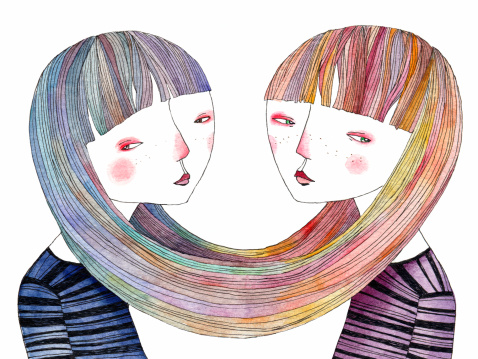The story of entangled twins is continuing in the Torah portion Vayeitzei (Genesis 28:10–32:3.) Structurally, it is very similar to the story in the previous Torah portion, Toldot (see “Entangled Twins”). In this portion, we again read about two entangled siblings—albeit, this time, sisters—about deception and spontaneous symmetry breaking.
Two sisters were Rachel and Leah. Moreover, according to Midrash, Rachel and Leah were also twins (Seder Olam Rabbah).[1] As inseparable twins, they were “entangled,” as it were. They were somewhat opposite—one introvert, the other extrovert; one beautiful, the other, perhaps not so much (she had “weak eyes”):
Now Laban had two daughters: the name of the elder was Leah, and the name of the younger was Rachel. And Leah’s eyes were weak; but Rachel was of beautiful form and fair to look upon (Genesis 29:17).

Rachel and Leah were earthly embodiments of spiritual constructs called partzufim—Divine visages, dynamic configurations of interincluded sephirot. Kabbalah teaches that there are two minor partzufim, partzuf Rachel and partzuf Leah—two sub-partzufim of the partzuf Nukva (Shechinah—the feminine aspect of G‑dliness). Partzuf Rachel represents the revealed aspect of the creation (alma d’isgalya) and the realm of speech (Olam HaDibur). Partzuf Leah represents the hidden aspect of the creation (alma d’iskasya) and the realm of thought (Olam haMachshavah).
As we discussed in the “Entangled Twins,” the entanglement with Esau allowed Jacob to trick his father, Isaac, by impersonating Esau. Similarly, in this Torah portion, the entanglement of two sisters allows their father, Laban, to trick Jacob by substituting Leah for Rachel on the wedding night:
And it came to pass in the evening, that he took Leah his daughter, and brought her to him; and he went in unto her (Genesis 29:23).
Ultimately, however, Jacob marries both sisters, because in the spiritual realm, Partzuf Ze’er Anpin (Z “A), the spiritual archetype of Jacob, couples with two female sub-partzufim—Partzuf Leah and Partzuf Rachel.
And just as in the previous Torah portion, Toledot, the symmetry between two brothers is broken by G‑d choosing Jacob, so too in this portion, the symmetry between two sisters is spontaneously broken by Jacob favoring Rachel, as it says:
And he loved Rachel more than Leah (Genesis 29:30).
We see how the same Divine drama plays out in two consecutive portions of the Torah as in two acts with a somewhat different cast of characters.
———————-
Endnotes:
[1] It is hard to reconcile this midrash with the plain text of the Torah, which says, “the name of the elder was Leah, and the name of the younger was Rachel” (Genesis 29:17). Midrash, however, is not concerned with the literal meaning of the text (peshat), but comes to expound the homiletical interpretation of the text (derush). Perhaps the midrash is trying to hint to us that, notwithstanding the fact that Leah was older than Rachel, that they were inseparable as twins, that is, in the modern language, they were “entangled.” (As in the section on the Entangles Twins, we use the quantum-mechanical term “entangled” metaphorically.)

